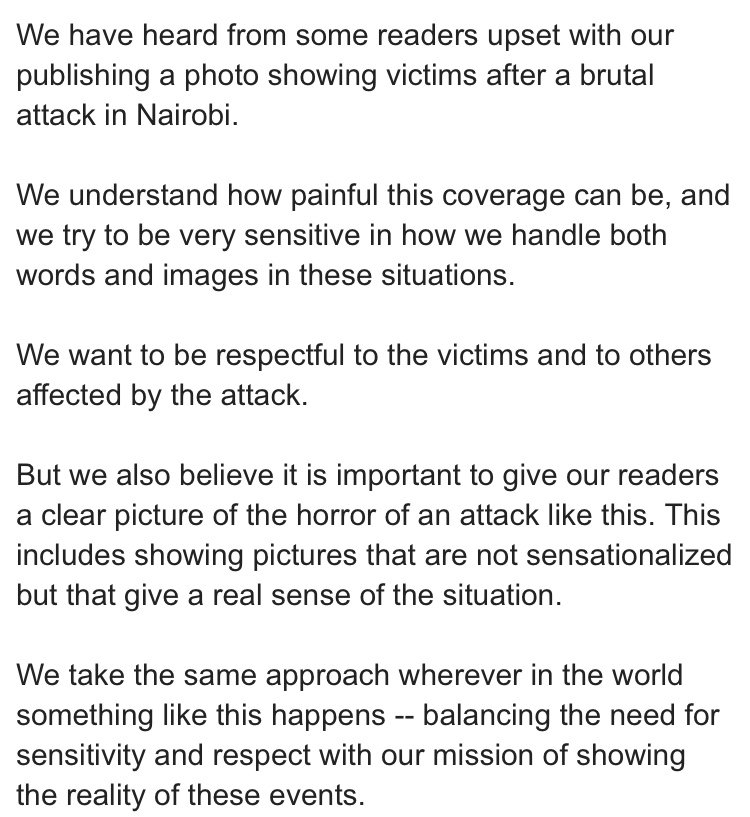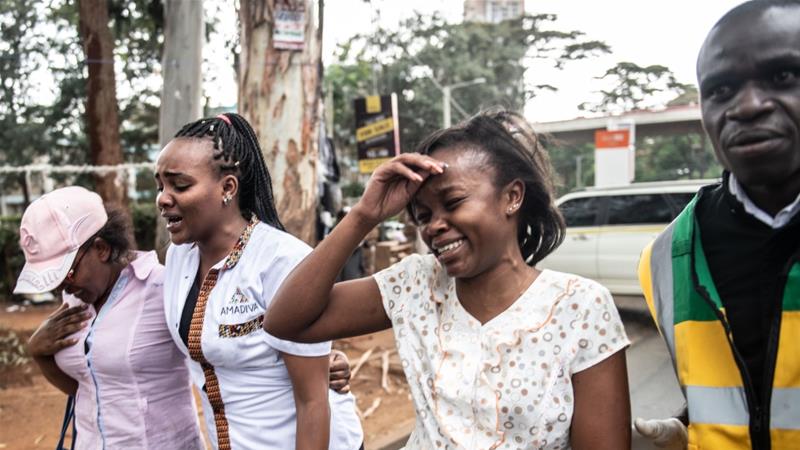Western media and depictions of death and injury to 'others'
Last week, when al-Shabab detonated bombs at an office complex and adjoining Dusit Hotel in Kenya's capital Nairobi, photo-editors at The New York Times made the decision to accompany the paper's incoming East Africa Bureau Chief Kimiko de Freytas-Tamura's report on the attack with gruesome images of the dead and injured. The response from Kenyans was swift.
Hundreds of people voiced their outrage about the newspaper's coverage of the brutal attack on Twitter. Most of the responses focused on the fact that it was not necessary for a newspaper to run images of the dead and injured in a manner that seemed blatantly disrespectful and dehumanising.
In one of the published images, which was attributed to Associated Press photographer Khalil Senosi, victims of the attack were seen slumped over on tables on which they had been, only moments ago, working on their laptops. It was especially troubling that editors made the decision to have the images go live asthe attack was still on-going and before everyone in the complex had been evacuated. Families of the dead had not even been notified.
New York Times' editors were no doubt surprised by Kenyans' reaction to their coverage - so much so that they felt the need to issue a statement:
But the newspaper's response to complaints and calls for accountability was so tone-deaf that it elicited even more critique and outraged reactions. Part of the issue people had with the editorial response was that it seemed to imply that the images were published because the attack in Nairobi was a "special" isolated incident, one that required especially gruesome images to depict "the truth" of what happened.
In their carefully worded response, the editors claimed that the paper wishes to be "respectful to victims and others affected by the attack," but also believe "it is important to give readers a clear picture of the horror of an attack like this." They insisted that the images they chose were "not sensationalized but give a real sense of the situation" and that they take a similar approach to "showing reality…wherever in the world".
But Kenyans were neither fooled nor placated. Many others in the Global South agreed, as they, too, had experienced - many times over - how powerful news organisations from the geopolitical West present what happens in their communities and countries in two-dimensional ways, often with little regard for how their words and images would affect those who were depicted.
Some pointed out that the backlash The New York Times received was not about a single photo or a story, but a long tradition of exploiting the most painful, brutal moments of those in geopolitical locations that the West continues to regard in a condescending, paternalistic manner - particularly those in Africa, the Middle East and Asia. Others shared examples of The New York Times' past reports on atrocities and terror attacks in the West, which did not include any gruesome images, to disprove the editors' claim that they would "show reality…wherever in the world" in a similar fashion.
And when, on the day after the attack in Nairobi, the Islamic State of Iraq and the Levant (ISIL, also known as ISIS) group attacked near a restaurant in Syriakilling several American soldiers, Kenyans compared The New York Times' coverage of this story - without photos of dead, white, American bodies - to its coverage of the attack in Nairobi and pointed out the newspaper's hypocrisy.
'Deport Kimiko'
The backlash over The New York Times' article was directed mainly at the journalist who penned the report, Kimiko de Freytas-Tamura. Even though she said she did not have total control over which photos were chosen to accompany her report, people argued that as the incoming East Africa chief of the news organisation, she should have some authority over the presentation of articles that carry her byline.
First, people asked her to remove the images as a show of respect for the families of the dead. When it became clear that the photos were not going to be removed, some Twitter users started a hashtag, #deportkimiko, demanding that she be deported from Kenya. Kenyans also launched a petition on Change.org, demanding that de Freytas-Tamura be fined or, if she is not currently accredited in Kenya, that any accreditation application she may make in the future be denied on the grounds of her recent conduct.
Following the calls for the journalist's deportation and the petition, m any members of the foreign press proceeded to lecture Kenyans on the value of a free press.
Feminist author Jill Filipovich, for example, called Kenyans' demands for deporting de Freytas-Tamura and petitions for an inquiry "anti-democratic" and "Trumpian" attacks on the free press.
In response to the charges that Kenyans are engaging in "anti-democratic" behaviour, many pointed out that such lectures on media freedom smack of a smug, "First World" brand of racist superiority. It is a defensive reaction that also allows powerful, privileged news organisations and their foreign correspondents to deflect attention from legitimate criticism of their practices by focusing on "irrational" "mob reactions".
Nairobi-based academic and writer Keguro Macharia presented a brutally honest response to the foreign media's criticism of Kenyans' anger. He said, in an interview over Twitter, that given the circumstances, high-minded journalists shouldn't be "tell[ing] grieving and frightened and enraged people about [journalistic] 'policy' to excuse … s****y behaviour". Further, he noted, "freedom of the press really needs to be distinguished from the foreign press…do[ing] whatever they like. One is about critiquing state excesses and advancing democracy. The other is not necessarily that."
The influential filmmaker, musician, and artist Jim Chuchu, meanwhile, argued that Kenyans' reactions on social media, cumulating in the petition, highlighted the ways in which "the ecosystem of global media", which sends "foreign press to 'cover Africa'", is rooted in broader, and inherently problematic, institutional practices:
Rachel Strohm, chair of the Mawaza Institute, clarified the power differentials that give rise to such insensitive and careless news reports:
She added that there is ample evidence showing that mainstream media in the US routinely treats black victims of violence differently, that "black people's lives are valued less than whites' in the US". Given that context, she argued, "#RiversideAttack photos are not an isolated incidence. They continue a long tradition of presenting white grief as important and black grief as irrelevant."
And, as Macharia reminded, in a Twitter thread:
"The West-African relationship is structured so that westerners *demand* unrestricted ..." and "unmediated access to our bodies, our lives, our loves, our grief, our houses, our emotions, our histories" and resent it when they do not get it instantly. And because this "has been the dominant relationship to Africa," it rears up no matter how “liberal or radical [you may be] in your home countries”.
Long term consequences
The images that The New York Times editors decided to use to accompany their report on last week's attack in Nairobi will have consequences beyond the current news cycle.
In an article ironically published in the very same New York Times in August last year, author Sarah Sentilles addressed the long term effects of "routinely view[ing], in every major media outlet, images and videos" the gruesome deaths of those in "other" geopolitical regions - as well "of black Americans being killed by the police" - while the bodies and injuries those we view as the "self" are respectfully elided.
Sentilles argued that this discrepancy - and "the very fact of visual access to the dead" from regions that we have historically positioned as "other" - creates and maintains a hierarchy. It encourages those in the geopolitical West to objectify the victims of terror and disaster in "other" lands as lesser beings who do not require the same level of dignity with which we would approach our own. Those others' lives in those far-away locations are less valued, their deaths less impactful, and thus less respect needs to be shown around their deaths. Moreover, "publishing some images while suppressing others sends the message that the visible bodies are somehow less consequential than the bodies granted the privilege of privacy."
In presenting these arguments for media restraint - and for powerful institutions like The New York Times to show some respect for the families of the dead - I am not advocating for censoring images or stories. I'm certainly not endorsing that members of the press or photographers are threatened with harm.
But it remains important that foreign journalists operating in Africa remember to examine and critique their positionality as they report on events in countries into which they have just "parachuted". Members of the foreign press should know that, as representatives of powerful news organisations, they have enormous power to influence the ways in which those in the "West" view "Africa" and "Africans". However, their reports often lack this necessary self-awareness and critique. Instead, their work reflects the lineages of power that come with Western news institutions and the fact of being in a "Western" body (which, no doubt, also depends on how a particular reporter is read as a "racialised" and gendered body) in a particular setting and context.
Most Western media outlets' reports on Africa continue to offer their readers predictable, contemporary versions of deeply problematic colonial images of "Africa" that allows them to safely imagine themselves as "civilised", and "Africans" as…well, you know the rest. But, as The New York Times recently found out, Africans are no longer staying silent. What Western media was used to doing without any pushback - or little to which their editorial board had to pay attention - is no longer possible.
https://www.aljazeera.com/indepth/opinion/western-media-depictions-death-injury-190122105451654.html


















0 Comments:
Post a Comment
Subscribe to Post Comments [Atom]
<< Home